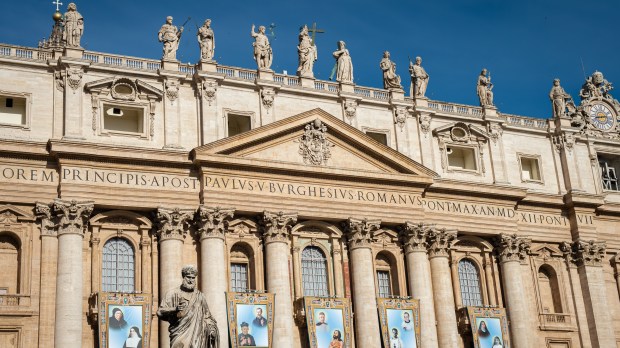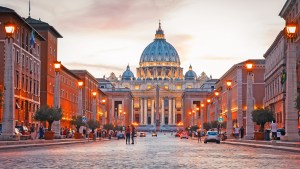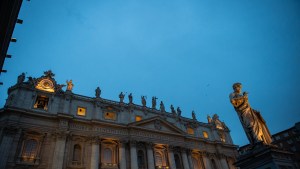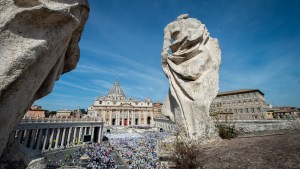The Institute for the Works of Religion (IOR)—commonly known as the Vatican Bank—will have exclusive competence over asset management and oversee the management of all the movable assets of the Holy See and its related institutions.
Pope Francis spelled this out in a rescript published on Tuesday in L’Osservatore Romano. The short five-article decree was published by the Vatican press office and L’Osservatore Romano the day after an audience granted by the pope to Cardinal Pietro Parolin, his Secretary of State.
The pope stipulates that the rescript “shall have the nature of an authentic interpretation of the provisions in force and shall have firm and stable force, notwithstanding anything to the contrary, even if it precedes the rescript or specifically refers to special issues.”
The rescript concerns Article 219, paragraph 3 of the Constitution on the Roman Curia Praedicate Evangelium.
It confirms the announcement made on July 19, 2022, when the Committee for Investments was created under the supervision of the Secretariat for the Economy.
The creation of this body was accompanied by the publication of a document setting out precise rules for investments made by the Holy See, including conformity with the Church’s social doctrine and the “productive” and not “speculative” purpose of the securities in which institutions are authorized to invest.
The relevant article is to be interpreted “in the sense that the activity of asset manager and custodian of the movable assets of the Holy See and of the institutions linked to the Holy See belongs exclusively to the Institute for the Works of Religion.”
For this reason, Holy See and related institutions “that possess financial assets and liquid assets, in whatever form they are held, with financial institutions other than the IOR must inform the IOR and transfer them to it as soon as possible within 30 days from 1 September 2022.”
The papal rescript enters into effect immediately.
A new step in the effort to trace funds
Among the “institutions linked to the Holy See” are a wide variety of structures, such as the pension funds of Vatican employees, the Health Assistance Fund, and the major basilicas of Rome. Among these, St Mary Major, which Pope Francis has visited a hundred times to venerate the icon of Mary Salus Populi Romani, was placed in trusteeship in December 2021 due to economic problems.
The pope appointed a Lithuanian prelate from the Secretariat of State, Msgr. Rolandas Makrickas, as an extraordinary commissioner to manage the economic assets of the Chapter of the Papal Basilica, which was in trouble because of the sharp decline in the number of pilgrims and tourists during the pandemic.
But the institution had also been weakened by scandals dating back several years. In 2014, a former administrator of the Chapter of St. Mary Major was sentenced by the Vatican court, for facts dating back to 2008, to four years in prison for fraud and misappropriation of funds. He also had to pay 250,000 euros to the Chapter. The requirement to centralize the funds of these various structures at the IOR could be aimed at avoiding the repetition of such abuses.
The distribution of roles between the IOR and the APSA
Contrary to what is often perceived in the common culture, the IOR is not the central bank of the Vatican but a private bank at the service of the institutions of the Holy See. In paragraph 219, the Constitution Praedicate Evangelium refers to the “instrumental action” of the Institute for Religious Works in “the execution of financial operations” carried out by the Administration of the Patrimony of the Apostolic See (APSA), which is the body responsible for the administration and management of the immovable and movable patrimony of the Holy See, destined to provide the resources necessary to carry out the functions proper to the Roman Curia for the good and at the service of the particular Churches.
The APSA therefore plays a treasury role and supervises the patrimony of the Holy See, while the management of financial flows is the responsibility of the IOR. The rescript puts an end to any margin of interpretation and to any request for exemption, while the “exclusive” character of the management of funds by the IOR was not clearly expressed in the text of the Constitution.
A vast project to adapt to anti-money laundering standards
The August 23 rescript is also part of the vast movement to restructure the finances of the Holy See initiated by Pope Francis since the beginning of his pontificate: the Council for the Economy (2014), the Secretariat for the Economy (2014), the Office of the Auditor General (2015), the Committee for Reserved Matters (2020) and the Committee for Holy See Investments (2022). In addition, the Secretariat of State has lost control of a large part of its funds.
The changes made since 2013 are aimed at a more rational distribution of functions, but also at greater transparency and efficiency in the fight against corruption — including modernizing the awarding of public contracts in 2020, and against money laundering — aligning on this point with the standards indicated by Moneyval, the European network specializing in these issues that has carried out several audits of the Vatican in recent years.




